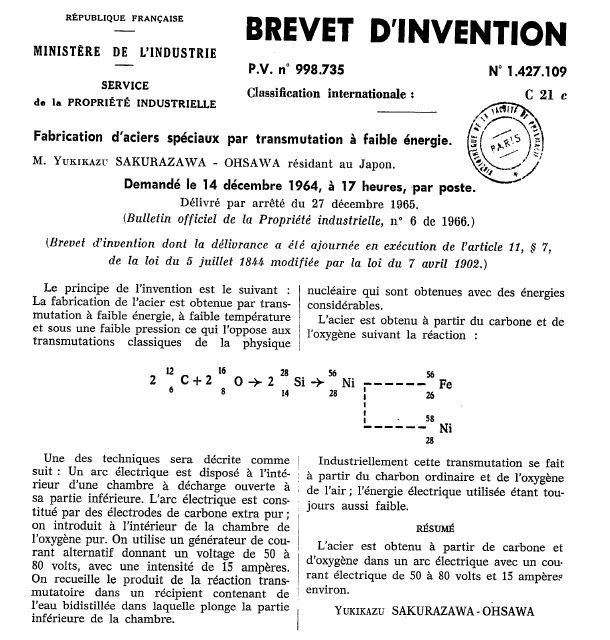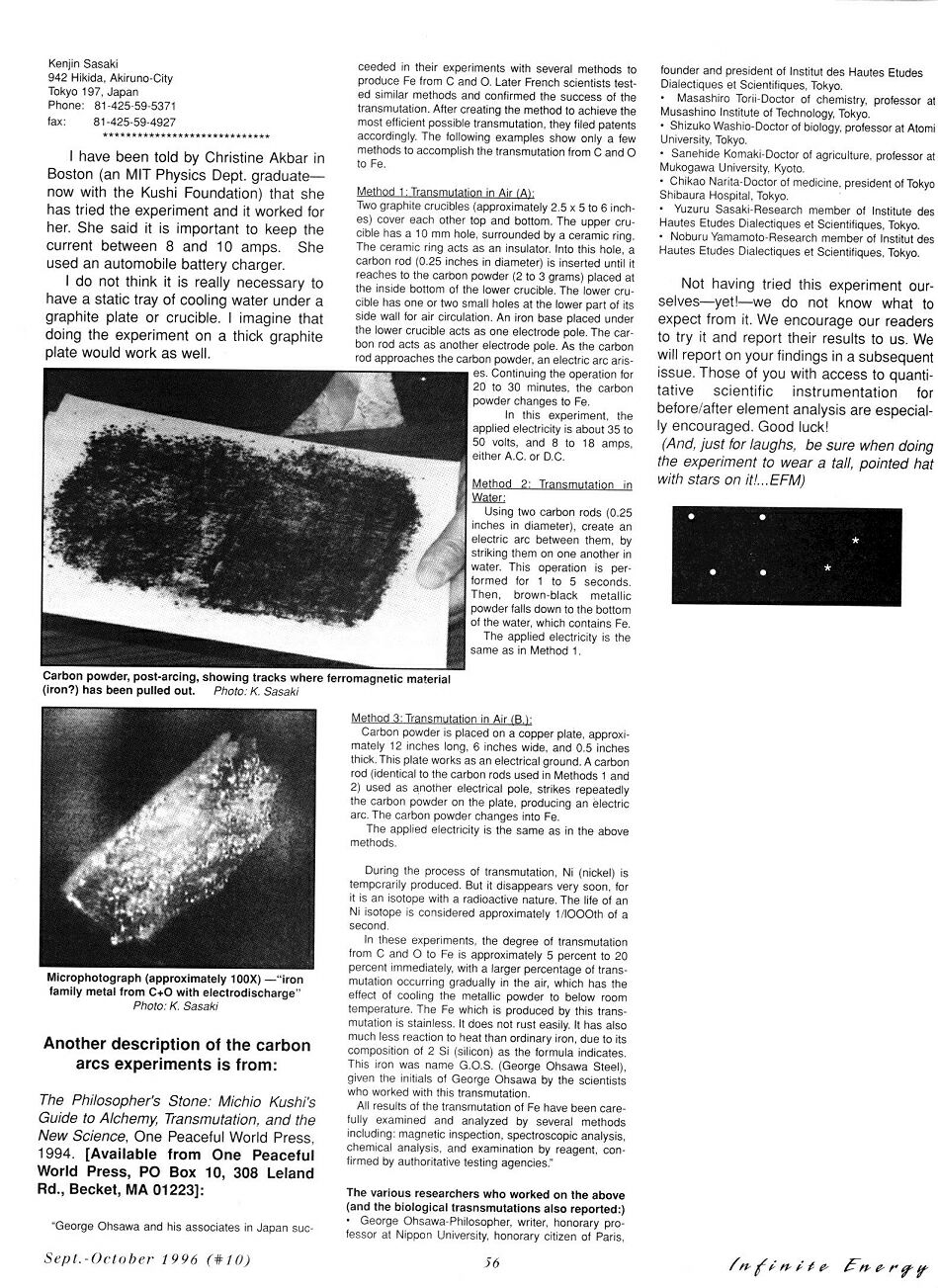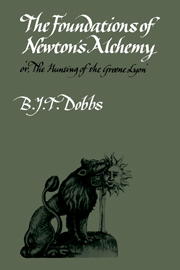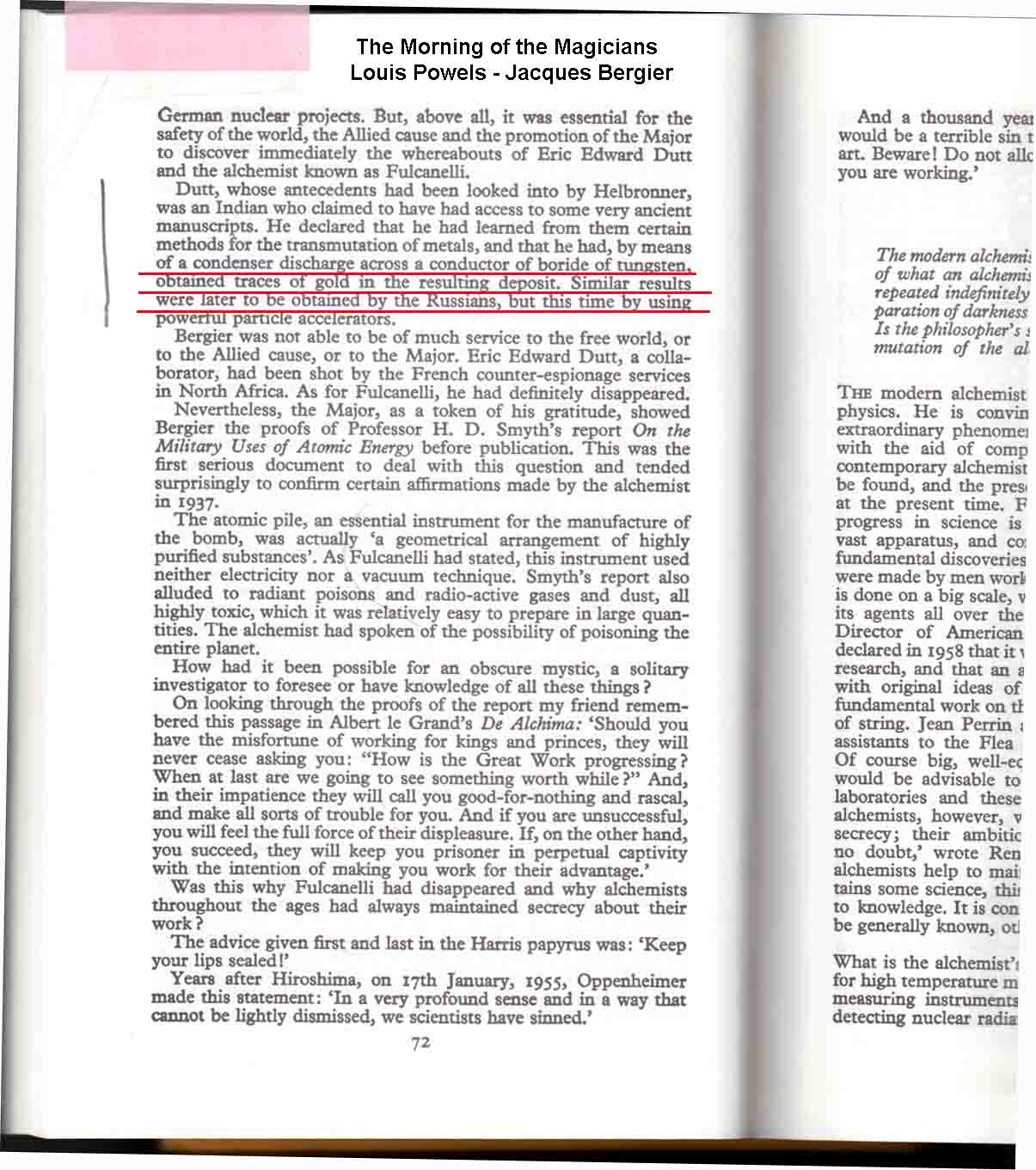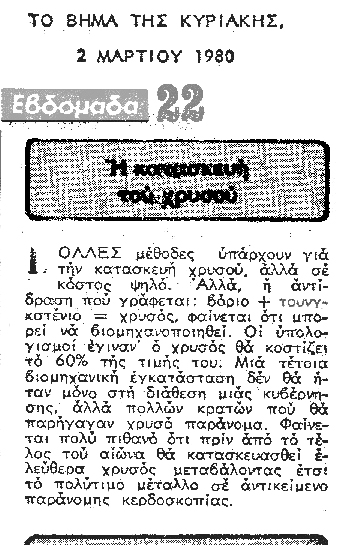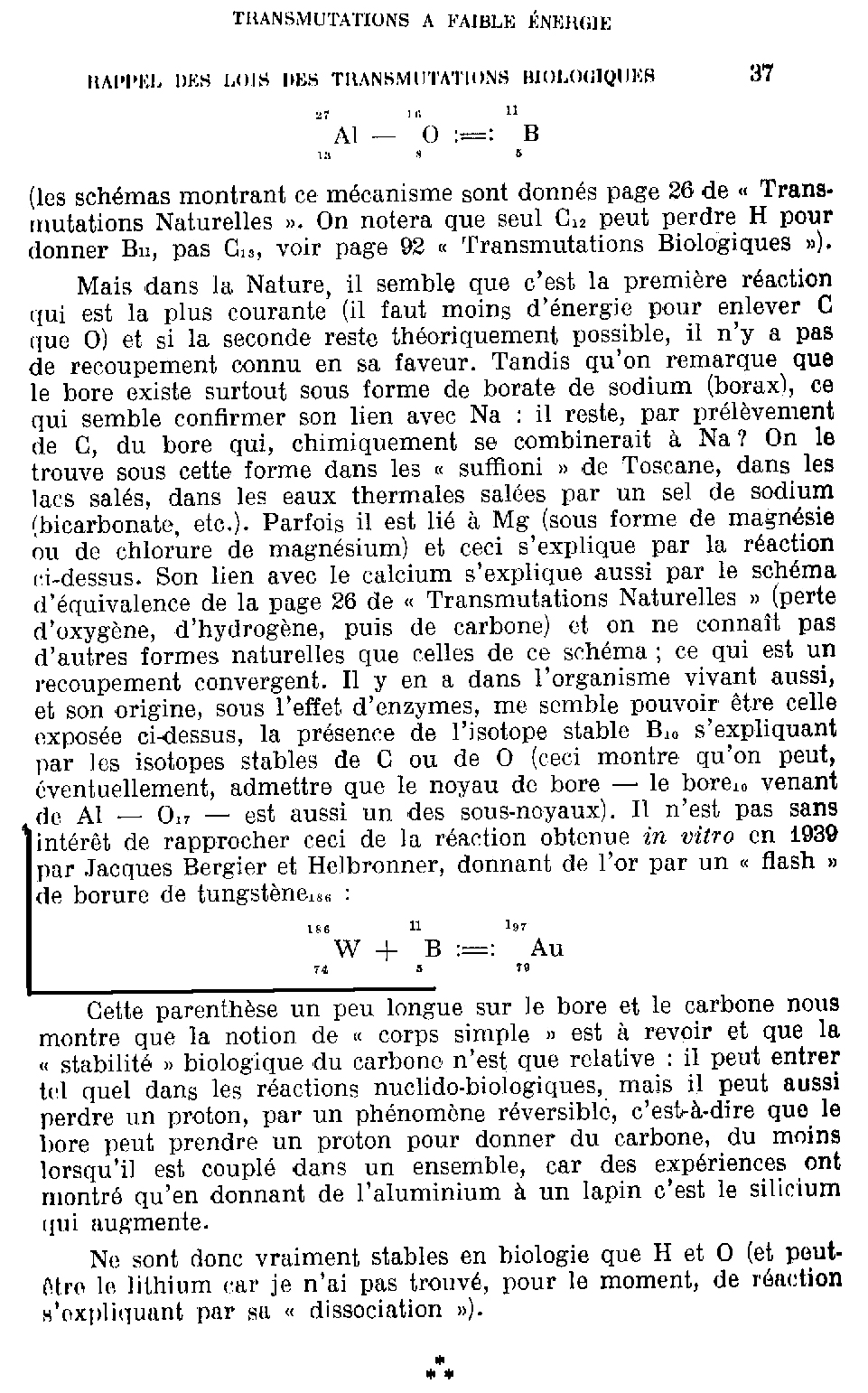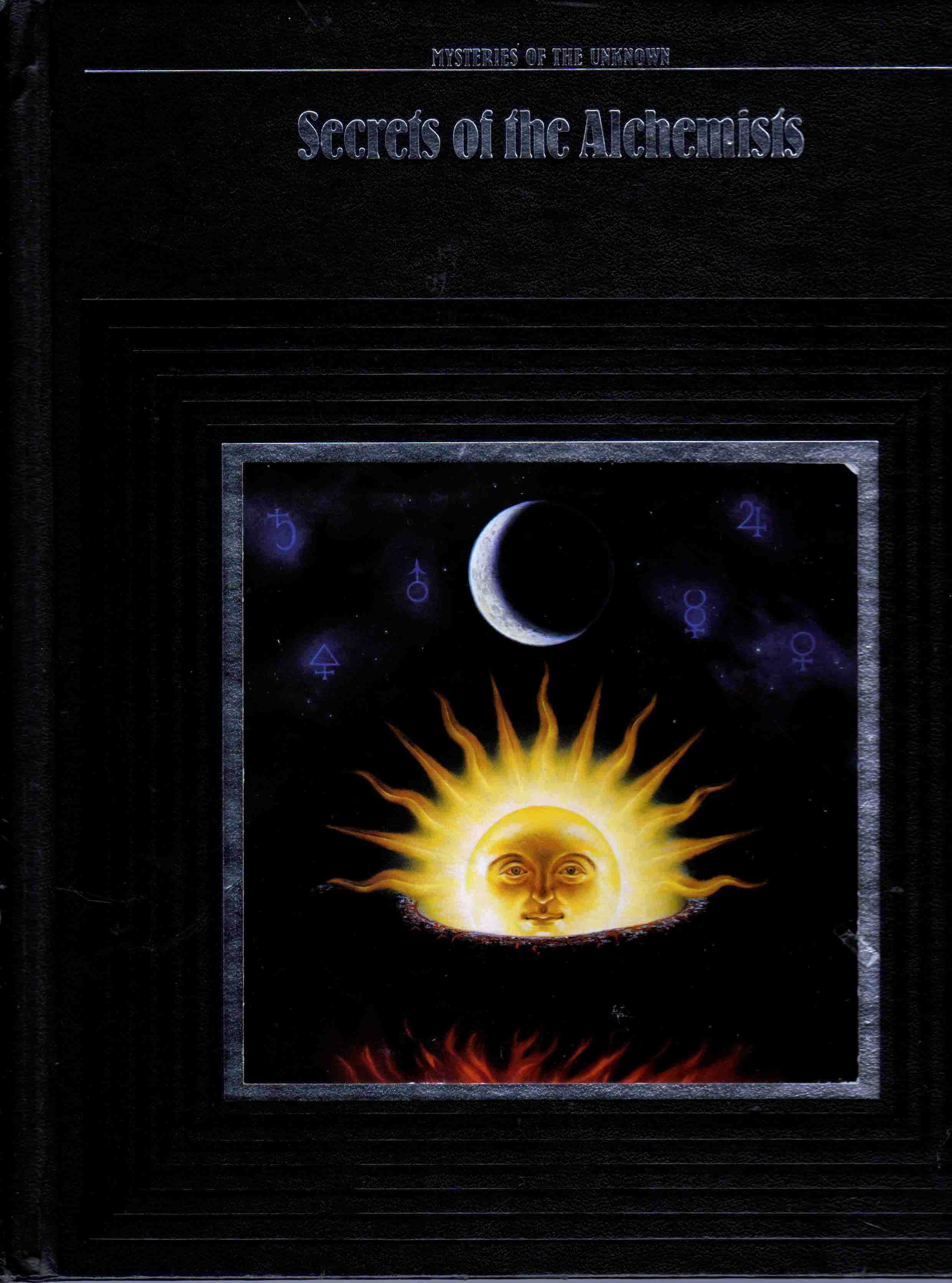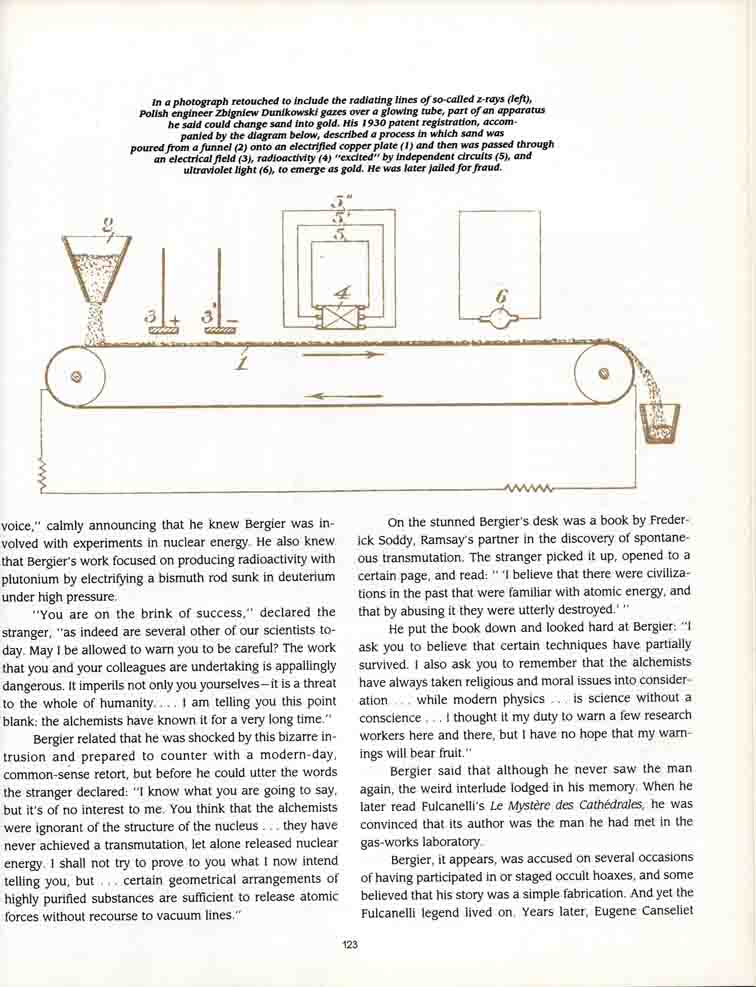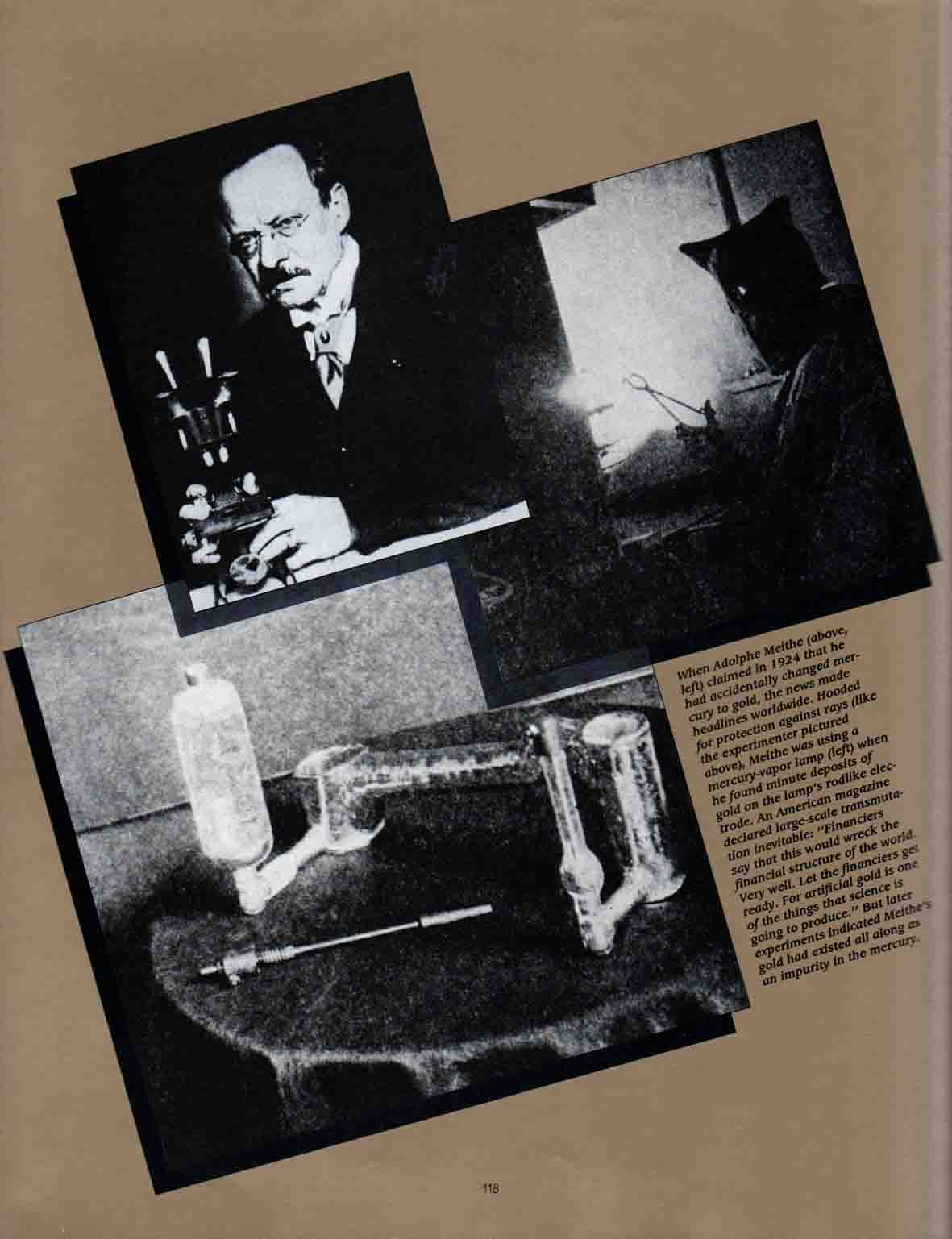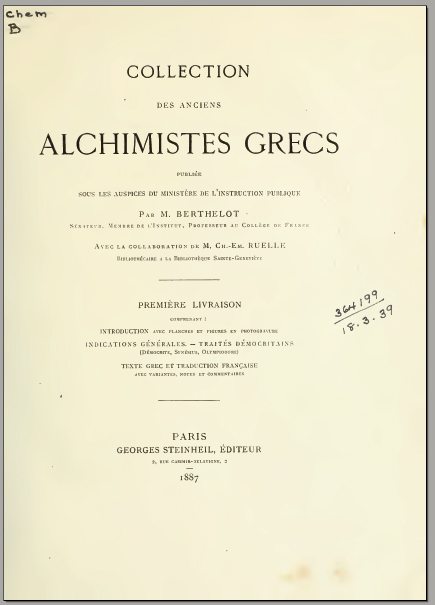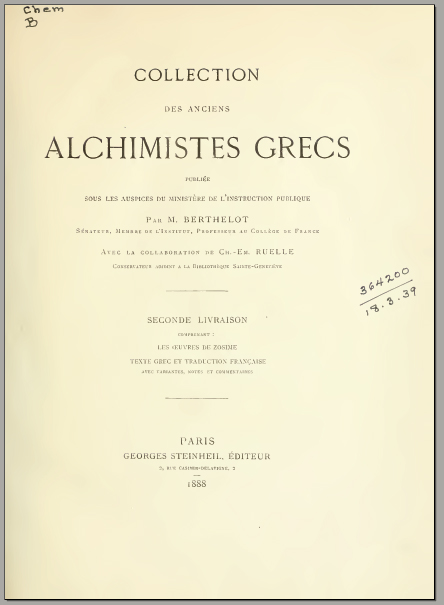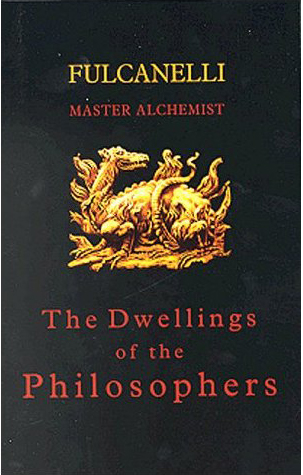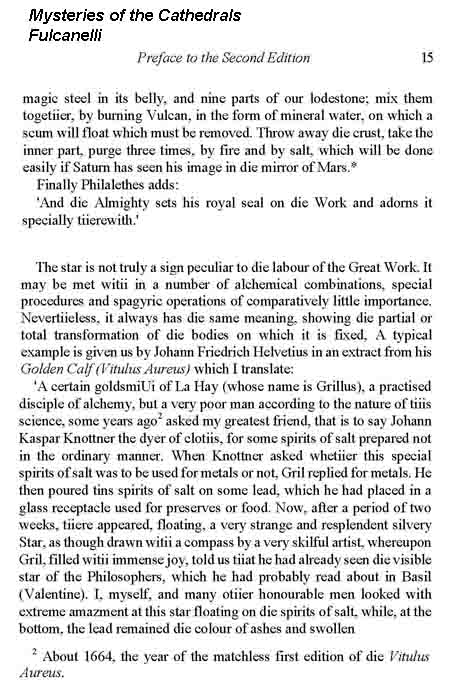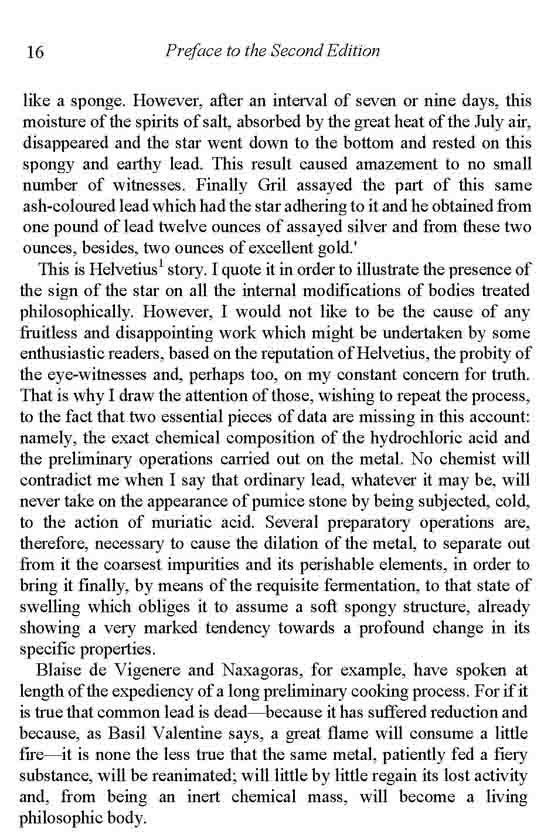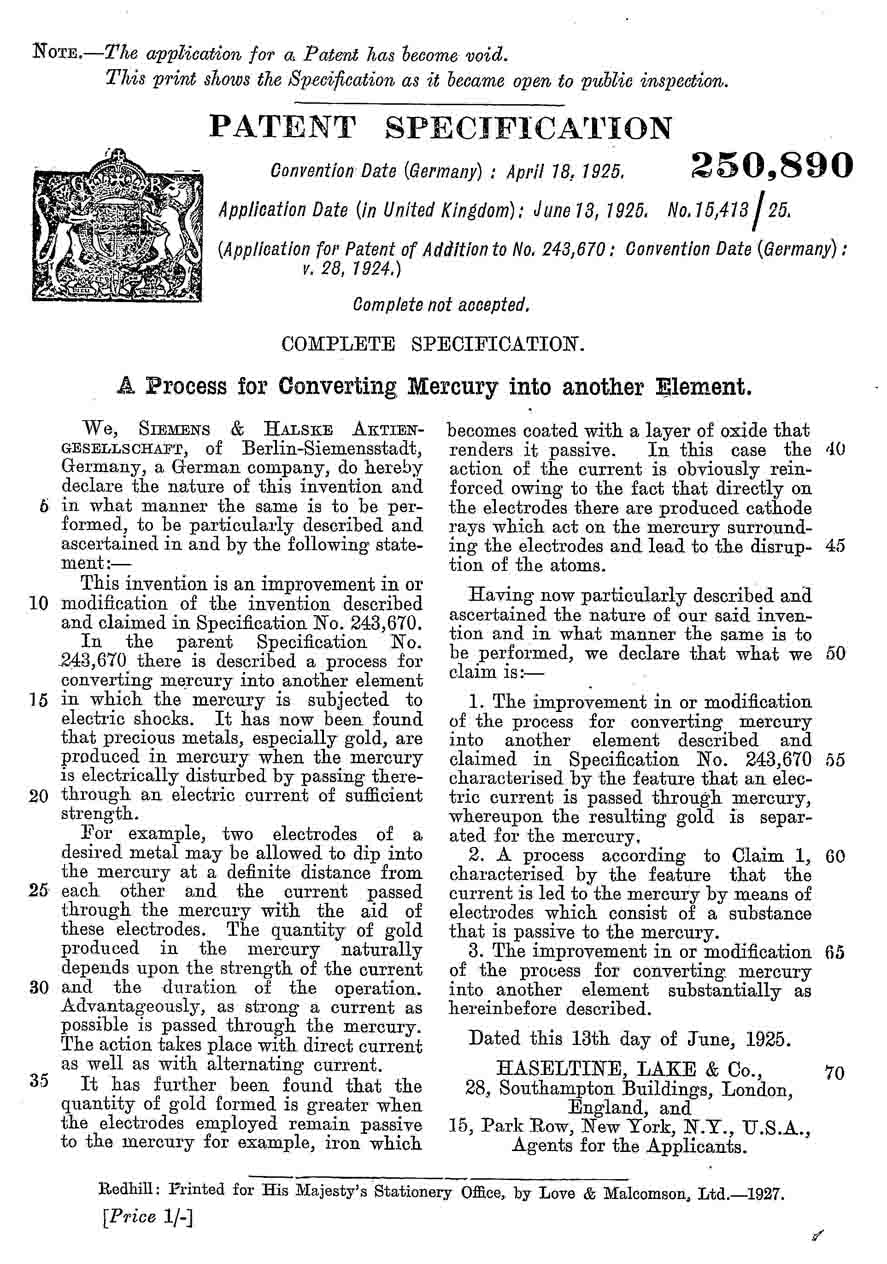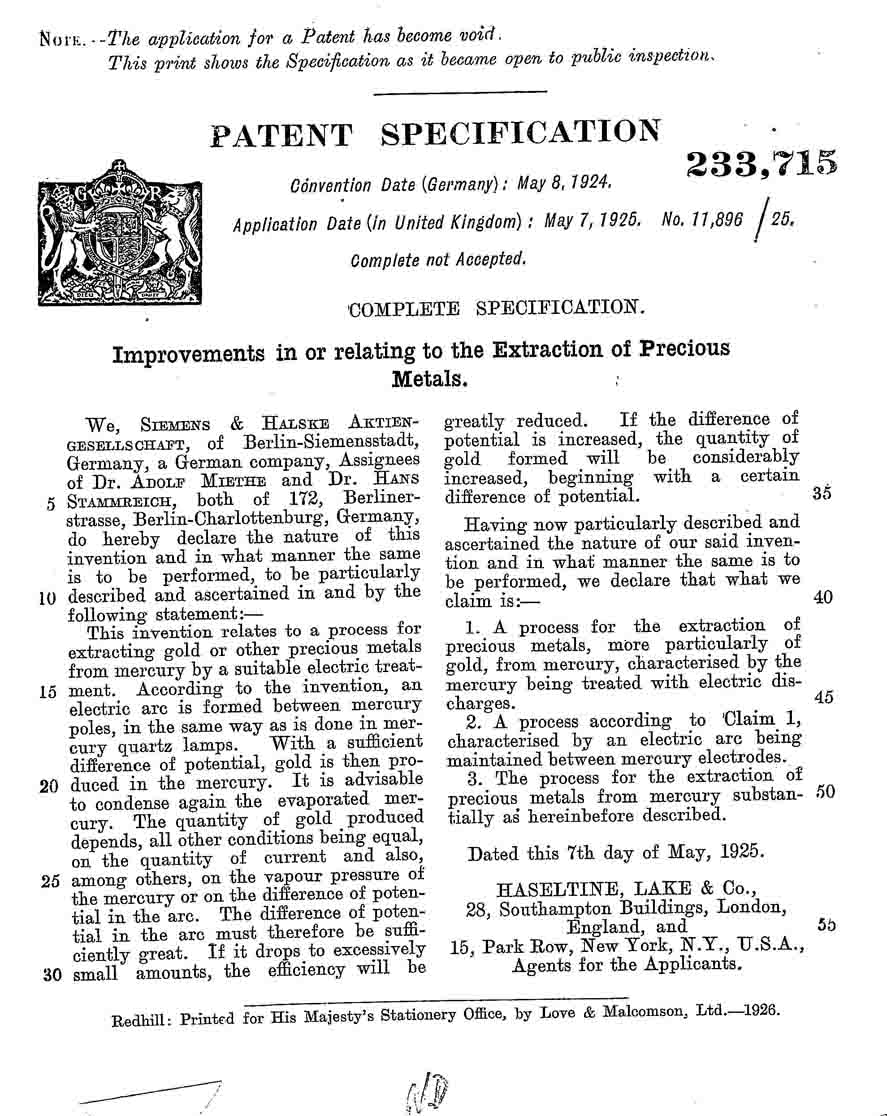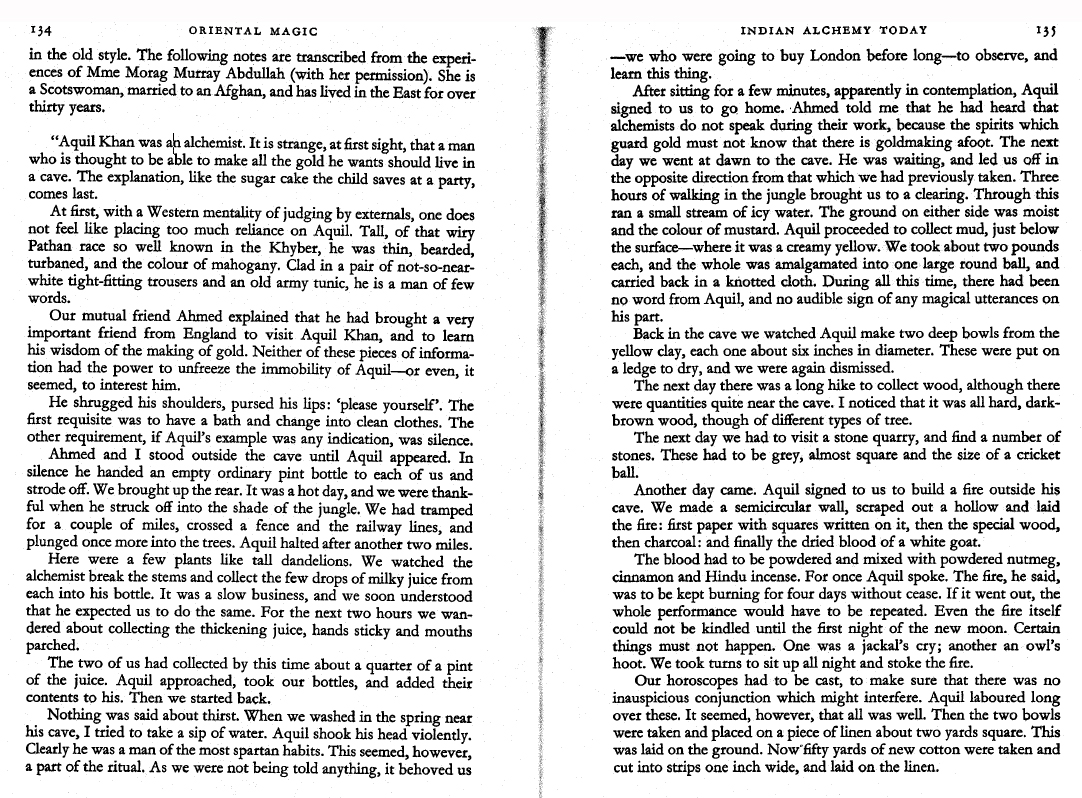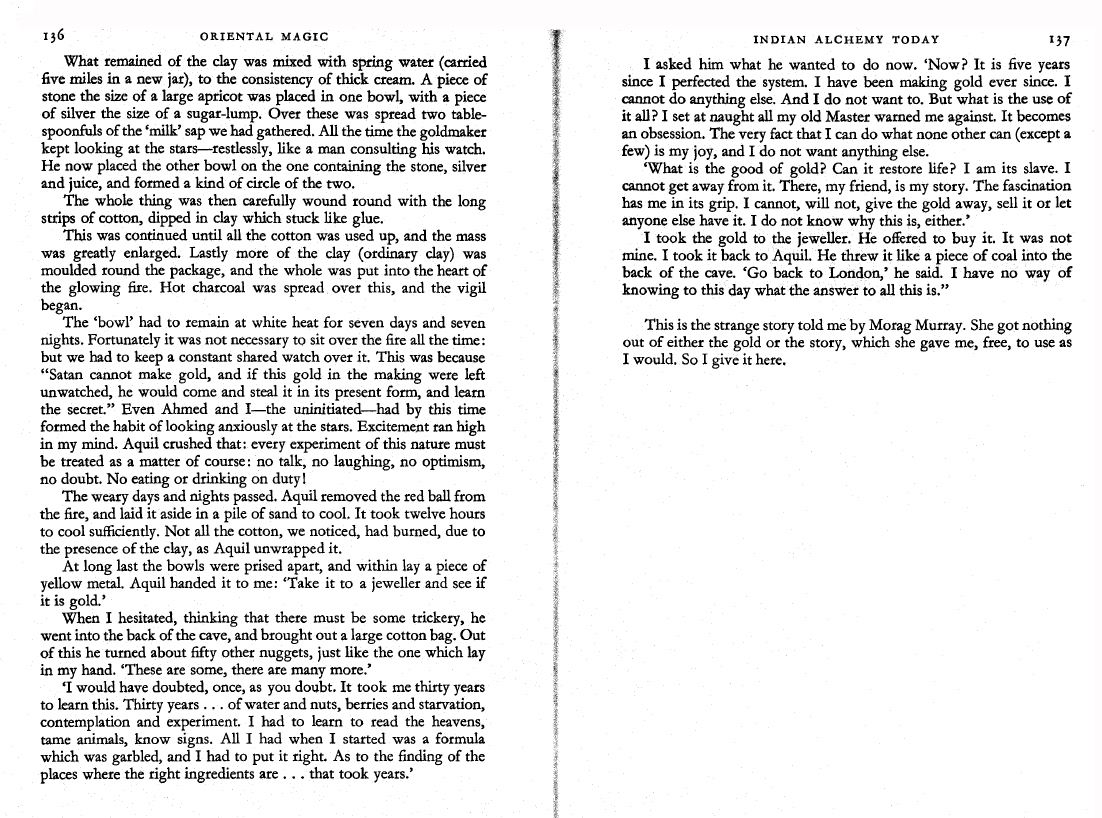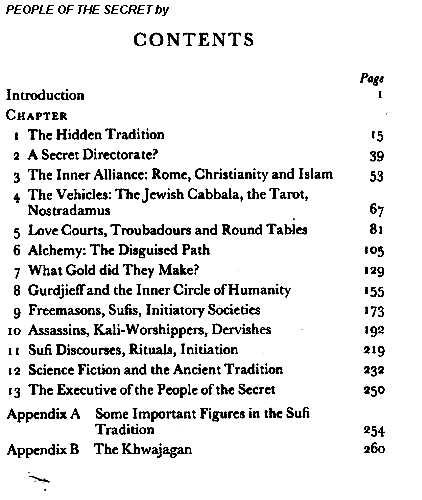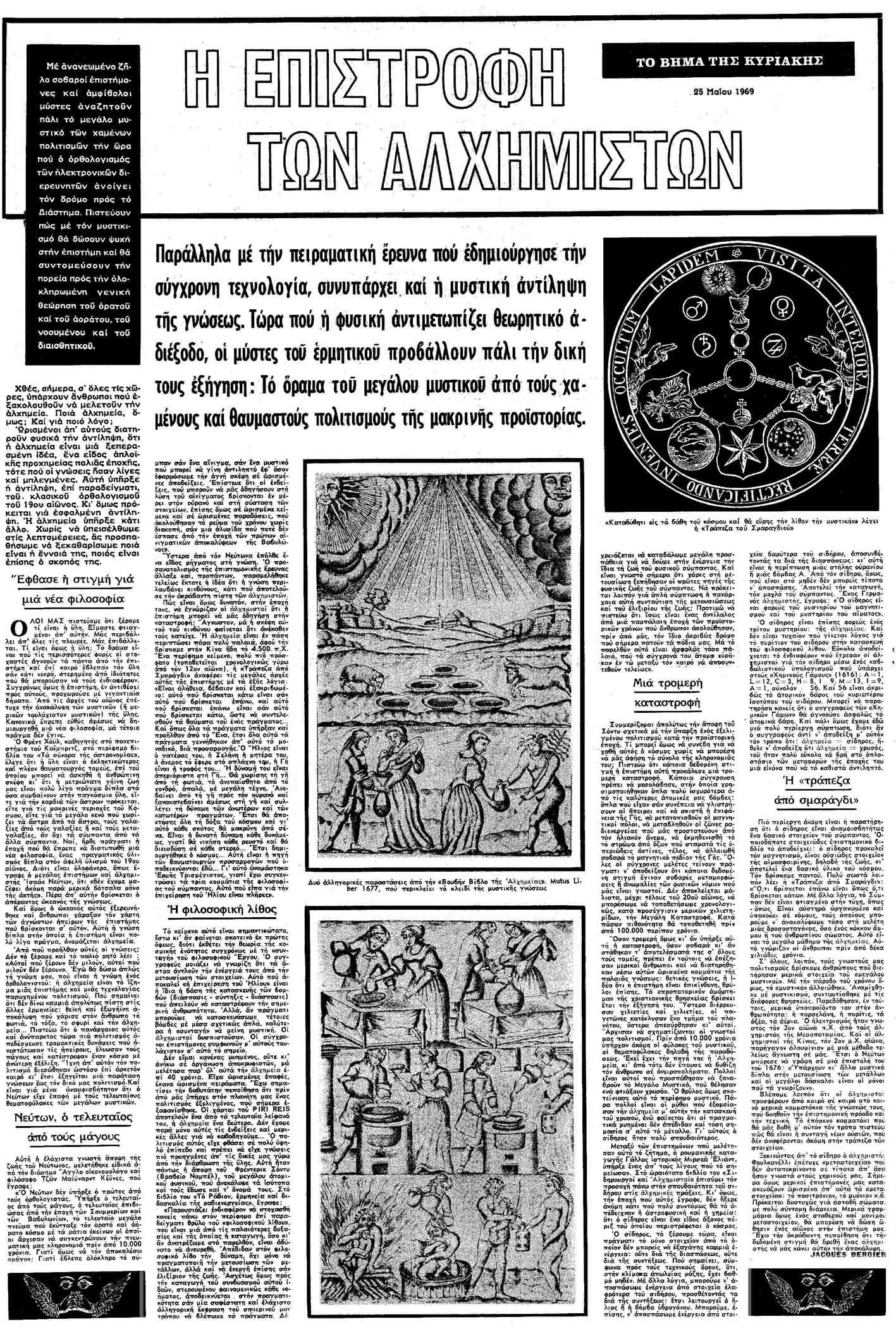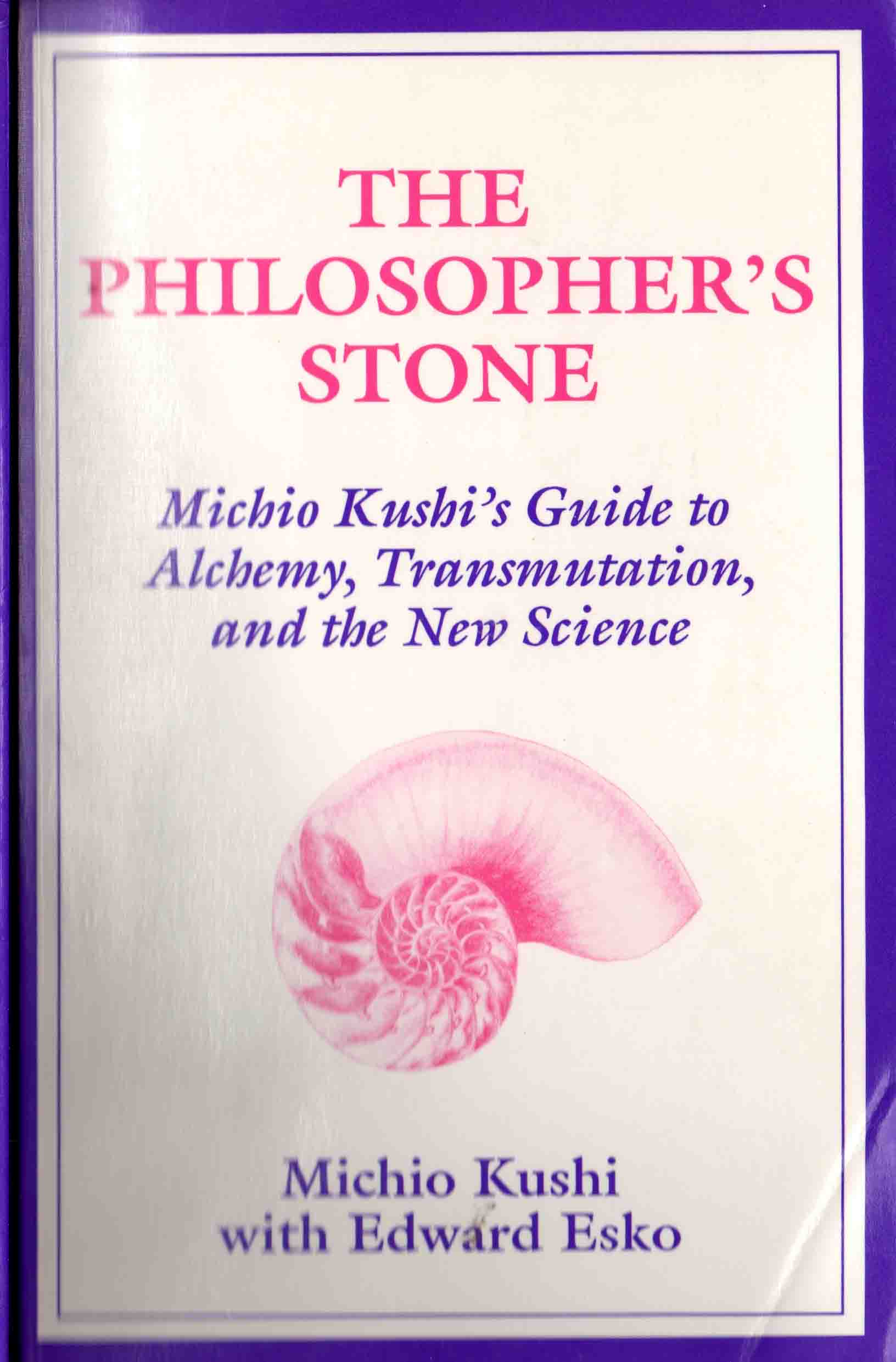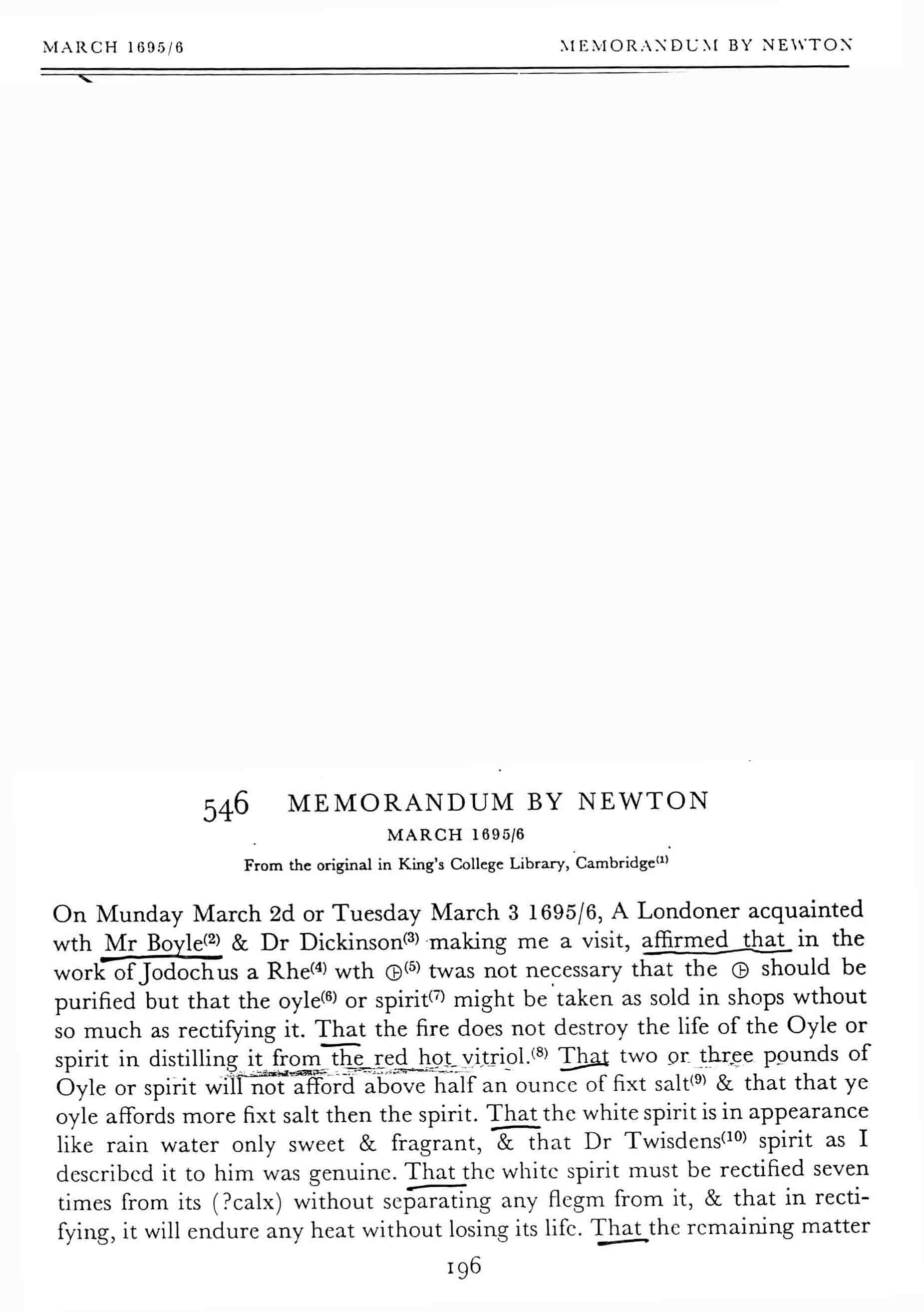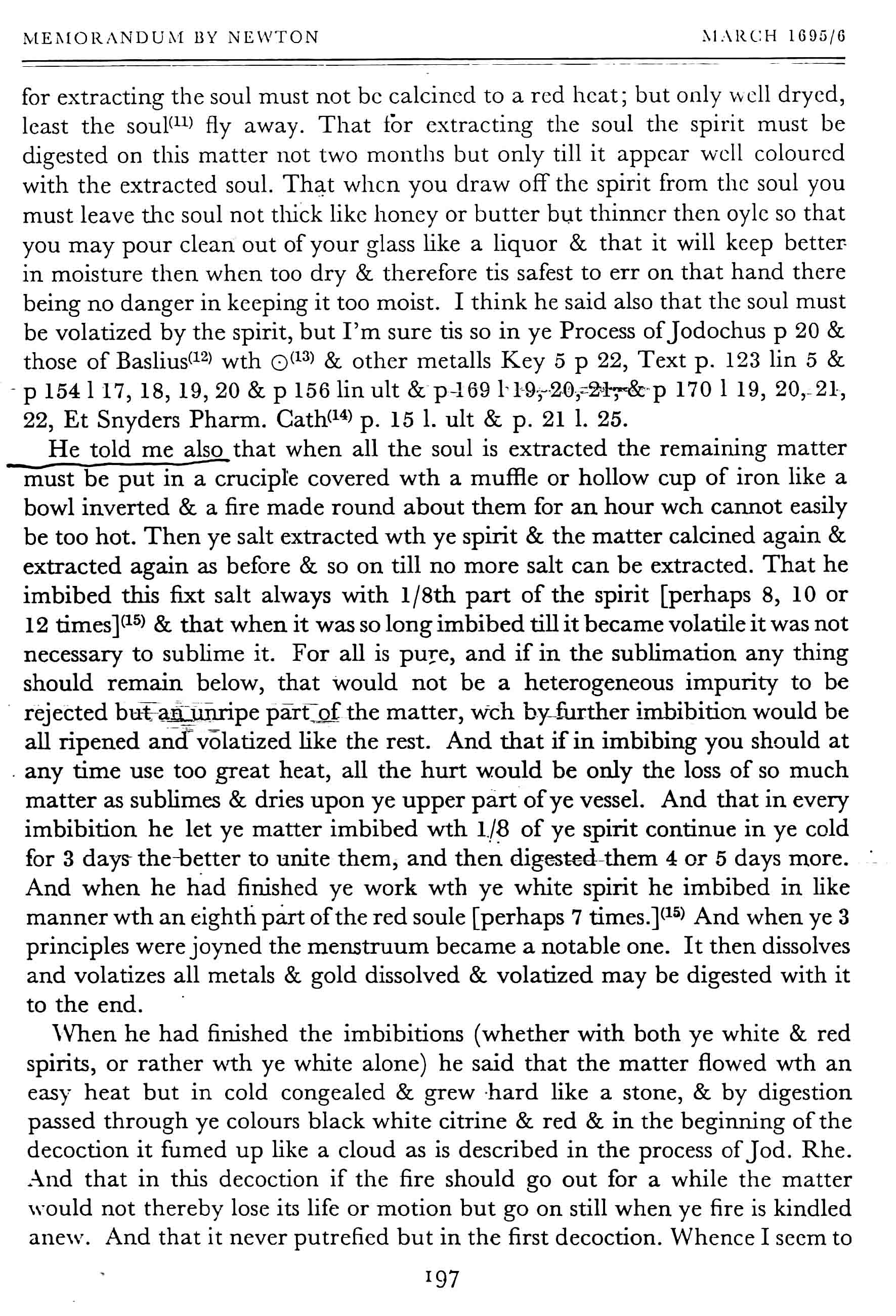(1)
M. Rulandus
(2)
T. Tiffereau
(3)
R. Hunter
(4)
A. Waite
(5)
Fulcanelli
(6)
F. Jollivet-Castelot
(7)
S. Emmens
(8)
C. Lea
(9)
J. Champion
(10)
References
Gold can be manufactured
from other elements by several methods. The
transmutation of silver to gold is the least difficult
to accomplish. The methods developed by Francois
Jollivet-Castelot offer a good chance of success, albeit
with great danger due to the use of arsenic. The
penultimate means of transmutation is the Philosophers'
Stone of any degree, but that is another matter
altogether.
Fulcanelli and others Adepts,
however, affirm that experiments such as these are not
Alchemy, but rather "hyper-chemistry" or "archymy". The
following procedures are included in this collection in
order to afford a wider perspective to all inquirers,
and to console those who fail to complete the Ars Magna.
Most of the 19th and 20th
century experimenters in this genre used a variety of
"wet" techniques (refluxing with nitric acid, etc.), or
"dry" transmutations with alloys in the furnace. Dr.
Stephen Emmens used high-pressure hammering (500
tons/sq. in.) of silver at low temperature, followed by
fluxing, granulation, more hammering, treatment with
"modified nitric acid", and refining.
(1)
Martin Rulandus ~ A Lexicon of Alchemy
Gold --- Its
Artificial Production ~ It is not only by the
common operations of mining and digging in the
profundities of the earth that it is possible to obtain
Gold. It is quite within the powers of Art to imitate
Nature in this matter, for Art perfects Nature in this
as in many other things. We propose to provide in this
place an account of a formal experiment, the worth of
which has been tested over and over again, and has in
fact become little less than familiar among operators in
the pursuit of the Grand Work. In order to perform it a
large crucible must be provided, and it must be of such
a quality as will be able to resist the action of
intense heat. This crucible must be set over a burning
furnace, and at the bottom of the vessel there must be
strewn Powder of Colophony (a kind of resin) to about
the thickness of the little finger. Above this undermost
layer there must be another layer of Fine Powder of Iron
--- that is, the Finest Iron Filings --- which shall be
of the same thickness. Subsequently, the filings must be
covered with a little Red Sulphur. Then the fire in the
furnace must be increased till the iron filings have
passed into a liquid condition. The next operation is to
throw in Borax --- that kind which is made use of by
goldsmiths for melting gold. To this must be added a
like quantity of Red Arsenic, and as much Pure Silver as
will be equivalent to the weight of the Iron Filings.
Let the entire composition undergo coction by driving
the furnace, taking care at the same time not to inhale
the steam, on account of the arsenic in the vessel. Take
then another crucible into which, by inclining the first
vessel, you must pour the cocted matter, having
previously stirred it effectually with an iron spatula.
Proceed in such a manner that the composition will flow
into the second crucible in a purified state, and devoid
of recremental matter. By means of the Water of
Separation, the Gold will be precipitated to the bottom.
When it has been collected, let it be melted in a
crucible, and the result will be good Gold, which will
repay all pains and expense which have been devoted to
its production. This chemical secret is contained in the
‘Hermetic Cabinet’, and the facility with which the
experiment can be performed has led many persons to
undertake it. The authority cited in support of it is no
less than that of the most learned Basil Valentine, who
also affirms that the operation of the Grand Work of the
Philosophers can be performed in less than three or four
days, that the cost should not exceed three or four
florins, and a few earthen vessels are sufficient for
the whole experiment.
(2) Theodore
Tiffereau
Between 1854-55, Theodore
Tiffereau submitted six memoirs to the French Academie
des Sciences concerning transmutations of silver to
gold. He published a compilation of the papers ( Les
Metaux sont des Corps Composes ) in 1855.(25-27)
Tiffereau conducted his
experiments at considerable expense while supporting
himself making daguerotypes in Mexico. Tiffereau claimed
that Mexican silver possesses peculiar qualities that
lend to its augmentation as gold (Dr. Emmens also used
Mexican silver in his work). While he claimed success in
principle, he made no capital gains. Tiffereau
demonstrated his process at the French Mint in Paris
before the assayer M. Levol, but the results were
unsatisfactory.
Tiffereau attempted many
modifications of his techniques, and claimed that
certain experimental conditions influence the
transmutation of silver to gold:
1) Pure silver filings were
used, sometimes mixed with pure copper filings (Ag 9:1
Cu) and traces of zinc, iron, alumina and silica;
2) Trace amounts of gold
catalyze the reaction;
3) The silver was refluxed with
concentrated nitric acid, hyponitrous acid, and nitrogen
protozide or deuteroxide;
4) Concentrated sulfuric acid
was used at times;
5) The acids were exposed to
sunlight to "solarize" them. Tiffereau complained that
the French sun was not so effective as the Mexican;
6) Halides and sulfur in the
presence of oxides of nitrogen improved the reaction,
and so did ozone;
7) Prolonged reaction time
increased yields.
Tiffereau attributed the
production of gold in the earth to the action of the
"microbe of gold". This was confirmed in the 1980s by
the discovery that placer gold nuggets form around a
nucleus of bacillus cereus.
The following experiment is
typical of Tiffereau's general methods:
"After having exposed, over two
days, pure nitric acid to the action of solar rays, I
added pure silver filings with pure copper filings in
the proportions of the alloy of money (9:1). A lively
reaction manifested, accompanied with a very abundant
deposit of intact filings agglomerated in a mass.
"The disengagement of nitrous
gas continued without interruption, and I left the
liquid as is over twelve days. I noted that the
aggregate deposit was augmented sensibly in volume. I
then added a little water to the dissolution in which
the product had precipitated, and again abandoned the
liquid to rest five days. During this time, new vapors
unceasingly disengaged.
"The five days having passed, I
raised the liquid just to ebullition, which I maintained
until the nitrous vapors ceased disengagement, after
which I evaporated it to dryness.
"The matter obtained from the
dessication is dry, dull, blackish-green; it did not
offer an appearance of crystallization...
"Placing the matter again in
pure nitric acid and boiling six hours, I saw the matter
become clear green without ceasing to aggregate in small
masses. I added a new quantity of pure concentrated
nitric acid and boiled it anew; it is then that I
finally saw the disaggregated matter take the brilliance
of natural gold...
[The third test in this series]
"presented an extraordinary phenomenon to be noted: the
quantity of the alloy that I used experienced a
transformation entirely to pure gold."
Carey Lea suggested that
Tiffereau and other experimenters had merely prepared a
gold-colored form of allotropic silver.
(3) R. M.
Hunter
In 1908, Sir Henry Baskerville
made mention of a contemporary claim to the production
of artificial gold:
"Among the many communications
reaching the writer, one is of more than passing
interest. Mr. R.M. Hunter, of Philadelphia, has written
concerning 'synthetic gold' as follows:
"I have so perfected the
process that in my judgment, based on my actual
experience, gold may be manufactured at enormous profit,
and to this end I have designed a plant to be erected in
Philadelphia and am at this moment negotiating for
$500,000 capital for its erection. I realize that the
public and most scientific men are adverse to the belief
in the possibility of such an enterprise, but I know
what I am doing and can afford to allow public sentiment
to follow its own course.
"Enclosed with the letter was
an affirmative affadavit. On request, Mr. Hunter
promptly forwarded me samples of silver in which the
gold is 'growing' and some 'grown-up' gold, said to have
been produced by his secret process. I have not made
analyses of the samples." (5)
(4) Arthur E.
Waite
The eminent occultist Arthur E.
Waite wrote A Collection of Alchymical Processes
which includes a segment entitled "Silver Transmuted
Into Gold By The Action Of Light":
"In the focus of a
Burning-Glass, 12 inches in diameter, place a glass
Flask, 2 inches in diameter, containing Nitric Acid,
diluted with its own volume of water:
"Pour into the Nitric Acid,
alternately, small quantities of a Solution of Nitrate
of Silver and of Muriatic acid, the object being to
cause the Chloride of Silver to form a minutely divided
state, so as to produce a milky fluid, into the interior
of which the brilliant convergent cone may pass, and the
currents generated in the Flask by the Heat may so drift
all the Chloride through the Light.
"The Chloride, if otherwise
exposed to the Sun, merely blackens on the surface, the
interior parts undergoing no change: This difficulty,
therefore, has to be avoided. The Burning-Glass promptly
brings on a decomposition of the salt, evolving, on the
one hand, Chlorine, and disengaging a metal on the
other. Supposing the experiment to last two or three
entire hours, the effect will then be equal to a
continuous midday sun of some 72 hours. The Metal
becomes disengaged very well. But what is it? It cannot
be silver, since Nitric acid has no action on it. It
burnishes in an Agate Mortar, but its reflection is not
like that of silver, for it is yellowish, like that of
Gold.
"The Light must therefore have
so transmuted the original silver as to enable it to
exist in the presence of Nitric Acid." ( 28)
(5) Fulcanelli
The renowned master Fulcanelli
published this transmutation of silver in Les
Demeures Philosophales:
"The simplest alchemic
procedure consists in utilizing the effect of violent
reactions --- those of acids on the bases --- to provoke
in the midst of the effervesence the reunion of pure
parts, their new arrangement being irreducible. In this
manner, starting from a metal close to gold ---
preferably silver --- it is possible to produce a small
quantity of the precious metal. Here is, in this order
of research, an elementary operation whose success we
guarantee, providing the instructions are carefully
followed.
"Empty into a glass retort,
tall and tubular, one-third of its capacity in pure
nitric acid. Adapt to the receiver an escape tube and
arrange the apparatus in a sand bath.
"Gently heat the apparatus
short of reaching the boiling point for the acid (83o
C). Turn off the fire, open the tube, and introduce a
small portion of virgin silver, or of cupel, free from
gold traces. When the emission of peroxide of azote has
stopped and when the effervesence has quieted, let drop
into the liquor a second portion of pure silver. Repeat
introducing metal, with no hurry, until the boiling and
issuing of red vapors manifest little energy, which is
indicative of the property of saturation. Add nothing
more. Let it rest for half an hour, then cautiously
decant your clear solution into a beaker while it is
still warm. You will find a thin deposit in the form of
black sand. Wash this with lukewarm water, and let it
fall into a small porcelain capsule. You will recognize
by making the assays that the precipitate is insoluble
in hydrochloric acid, just as it also is in nitric acid.
Aqua regia will dissolve it and yields a magnificent
yellow solution, exactly like gold trichloride. Use
distilled water to dilute this liquor; precipitate from
a zinc blade. An amorphous powder will be obtained, very
fine, matte, of reddish brown coloration, identical to
that given by natural gold reduced in the same manner.
Wash well and dessicate this pulvurent precipitate. By
compression on a sheet of glass or marble, it will give
you a brilliant, coherent lamina with a beautiful yellow
sheen by reflection, green by transparence, having the
look and superficial characteristics of the purest gold.
"To increase with a new
quantity this miniscule deposit, you may repeat the
operation as many times as you please. In this case,
take up again the clear solution of silver nitrate
diluted from the first washing water; reduce the metal
with zinc or copper. Decant this silver into a powder
and use it for your second dissolution." (14)
(6) Francois
Jollivet-Castelot
Francois Jollivet-Castelot was
the Secretary General (and later President) of the
Alchemical Society of France (founded in 1896). He also
edited the Society's journal L'Hyperchemie, and
served as a special delegate of the Supreme Council of
Martinists. He authored several books and articles on
alchemy and "hyperchemistry", a system of non-occult
chemical methods of transmutation. (17-20)
Jollivet-Castelot began
experimenting with transmutations of silver in 1908. In
1920, he published La Fabrication Chimique de L'Or
to report his successes using both "wet" and "dry"
methods of transmutation:
"By means of catalytic action I
have succeeded in manufacturing gold chemically by
acting on silver with arsenic and antimony sulfides,
tellurium, and tin.
"This process gives a very high
yield which has already been confirmed by several
chemists, in particular by Mr. Ballandras, Chemical
Engineer of Lyons, and Mr. Outon, Chemical Engineer of
Buenos Aires...
"The object of the present
leaflet is to enable chemists to repeat and check my
experiments in their turn...
"I made a mixture composed of 3
gr of chemically pure silver and 1 gr of chemically pure
orpiment and placed it in 36o nitric acid for
several months cold and then brought it to ebullition.
The liquid was kept at the boiling point for several
days. A small quantity of the material became detached
at this moment and formed a pulvurent black deposit.
When no further action took place, I decanted off the
solution and collected the insoluble residue. This
residue was attacked by aqua regia at the boiling point
until it was almost completely dissolved; the liquor
when decanted and filtered was analyzed and gave all the
characteristic reactions for gold.... [December 1925]
"I acted on 22 gr of chemically
pure silver ... and on 3.5 gr of chemically pure
orpiment... The mixture was heated to about 1600o
C In a metal smelting furnace for about three quarters
of an hour. The residue obtained was again melted with
the addition of orpiment. After having hammered for half
an hour and remelted with the addition of small
quantities of orpiment every ten minutes, it was
withdrawn.
"After cooling and the addition
of chemically pure antimony sulfide, it was again put
back into the furnace, small quantities of orpiment
being thrown in every five minutes. The residue obtained
had a dark metallic tint. After hammering it became
slightly golden.
"The residue dissolved in
chemically pure 36o nitric acid first cold
and then hot, gave an abundant pulvurent deposit. This
deposit after being washed and treated with ammonia to
dissolve the arsenic and antimony salts was completely
dissolved in aqua regia. The liquor then being
chlorinated and filtered was subjected to the reagents
of platinum and gold. Mr. Andre Vandenberghe who was
acting as preparator for this experiment, had thought
that in accordance with the law of the evolution of
matter, the transmutation of bodies into gold should be
preceded or accompanied by their transmutation into
platinum...
"The reactions of gold were
quite characteristic; the reactions of platinum also
seemed to reveal its presence.
"The quantity of gold obtained
in this experiment was about one gramme.
"I submit the hypothesis that
the arsenic acts as a catalyst and the sulfur as a
ferment in this transmutation." (December 1925; Douai,
France)...
"As a sequel to my previous
work on the artificial synthesis of gold, I have
introduced tin into these new tests as it is also often
associated with gold in Nature. The following is a
description of this new process, thanks to which the
percentage of gold obtained destroys all the objections
that are raised with regard to impurities.
"I made an intimate mixture of
6 gr of chemically pure silver... 2 gr of antimony
sulfide, 1 gr of orpiment, and one gr of tin... I then
added the usual fluxes and then heated the whole in a
crucible in the furnace to about 1100o C for
about one hour, twice adding a small quantity of SbS.
"The residue obtained was
treated for a long time in 36o nitric acid,
first cold and then at the boiling point; the insoluble
residue was next washed with distilled water, treated
with ammonia, washed again and finally treated for a
long time with boiling aqua regia.
"The liquor when filtered and
subjected to the reagents of gold showed the presence of
this metal in the form of abundant deposits which may be
estimated at 0.05 gr in all, which is very high
considering the 6 gr of silver employed. The deposits
when collected and dried had a yellow green metallic
color and possessed all the characteristics of gold...
"The addition of tin to the
other bodies has certainly facilitated the reactions of
the gold and increased the yield of this metal which can
be manufactured artificially by my process, i.e., by
synthesis and in measurable quantities.
"It would be very easy to show
that, given the respective prices of gold and of the
other substances that are used in my process to produce
it, a profit could be obtained if the process were
worked industrially, all the more so as the greater part
of the silver employed can be recovered at each test..
"I believe I now hold the key
to the regular and even industrial manufacture of gold.
"But the industrial question is
voluntarily put aside from my thoughts, for my only
object is the search for pure scientific truth."
In a correspondence to
Jollivet-Castelot, Mr. Ballandras reported on "How I
Succeeded In Making Gold According To The Process of Mr.
Jollivet-Castelot: Dosage of gold obtained by the second
method":
"From a mixture of 10 gr
silver, 3 gr of tin, 3 gr of arsenic sulfide, and 3 gr
of antimony sulfide, the residue which had been obtained
was crushed as much as possible and subjected to a
treatment of pure chloric acid like in the first method.
However, in order to completely eliminate the silver and
the tin employed, I scrupled to begin again the
indicated treatments, that is as much to say that the
powder which was obtained having been subdued first to
the action of azotic acid, then washed with distilled
water, then subdued to the action of chloric acid, then
washed with distilled water, then once more washed with
distilled water, and these different operations were
begun once again with another portion of pure chloric
acid... The insoluble residue was subdued to the
prolonged action of aqua regia...
"It must be noted that this
thing happened during the ebullition. The washed residue
contained the slighter part of gold; this thing would be
found dissolved in the last liquor which I obtained.
"After 18 hours of digestion at
about 25o, I subdued the mixture to
ebullition during 3 hours. After refrigeration, I
filtered on glass wool and I looked if parts were not
drawn along in suspense. I found nothing. Then, I
decided to proceed to a circumstantial analysis of the
liquor which I obtained...
"The quantity of gold which was
obtained was 0.476 gr for 10 gr of silver employed, or
0.0476 gr of gold per gram of silver."
Jollivet-Castelot read this
memorandum to the Academie Royal des Sciences (Belgium)
on June 6, 1926:
"A Recent Experiment In
Transmutation --- All my research work on
transmutation since 1908 has started from the fact that
gold is found in nature associated with antimony and
arsenic sulfides as well as with tellurium, which is
considered as a mineralizer of gold. I therefore
considered that it was logical to introduce tellurium
into the artificial combination of silver and arsenic
and antimony sulfides that I make...
"I prepared a mixture composed
of 6 gr of silver, 1 gr of native orpiment free of gold,
1 gr of antimony sulfide and 2 gr of tellurium... I
added pure silica to the usual fluxes. This mixture was
heated in the furnace in the usual way for one hour at
about 1100o C. The residue obtained was of a
blackish-grey color with violet reflections. It weighed
6.42 grams.
"When subjected to the action
of nitric acid, the residue was attacked with difficulty
and greenish metallic particles become detached. The
solution was then decanted and a greenish-yellow residue
remained which was kept at the boiling point of nitric
acid for several hours. After decanting off the liquor
once again, the residue, which had not changed, was
washed, treated with ammonia and then subjected to the
action of boiling aqua regia in which it was entirely
dissolved after boiling for several hours.
"[The solution was chlorinated
and subjected to the reagents of gold with positive
results, although] a certain amount of gold was
certainly lost in this test just as in all my previous
tests, for it is known that arsenic, antimony, and
tellurium entrain gold in their fusion and their
volatilization.
"In order to obviate this
disadvantage, I had thought of making the vapors of
arsenic acid and antimony sulfides and of tellurium act
on the silver in fusion in a closed vessel by means of a
special device...
"I consider it certain that if
the vapors were allowed to bubble through the melted
silver, a much higher yield of gold would be obtained
than that I have obtained hitherto by an imperfect and
too rapid contact of the bodies in presence, while it is
undoubtedly necessary to make them react on one another
in the vapor state in a closed vessel."
Mr. Louis Outon, a
pharmaceutical chemist in Buenos Aires, reported to
Jollivet-Castelot in a letter (July 26, 1927):
"Dear Sir... I have repeated
the experiments... in my laboratory and am amazed at the
results. For the moment, it is only the scientific side
which interests me, since the cost of the gold obtained
is often greater than the value of the metal..."
Mr. A. Ballandras also
replicated the experiments and reported the results:
"I will not conceal the fact
that I have often heard ironical remarks aboutprocesses
by which he succeeded in manufacturing gold. I
determined to check his tests with the greatest possible
accuracy...
"In a new quartz crucible, I
placed 15 gr silver, 6 gr arsenic sulfide, 6 gr antimony
sulfide. The crucible was heated at a temperature of 500o
C and then for one hour and a half at 1100o
C. At this moment the mass was fairly liquid... The
crucible was then allowed to cool down. The
reddish-brown residue obtained weighed exactly 23.742
gr, or a loss of 3.258 grams.
"I allowed this residue to cool
in pure nitric acid in which the greater part was
dissolved fairly easily. After prolonged boiling the
liquor was filtered on a new glass wool. The resultant
liquor was very clear and absolutely free of any
particles.
"The glass wool was then
macerated in aqua regia rich in hydrochloric; after 18
hours maceration, the whole was boiled for 3 hours. I
again filtered on glass wool in order to separate any
traces of the filter from the liquor... Any gold that
might have been obtained would necessarily be found in
the last liquor... It was of importance to prove its
existence qualitatively at least.
"For this purpose, I tried the
various standard reagents, the results being the
following: 1) Oxalic acid: flakey precipitate; 2) Iron
sulfate: glossy metallic black; 3) Tin chloride: peach
pink precipitate; 4) Formol: rather light bluish
coloration; 5) Sodium carbonate, potassium carbonate:
light coloration after boiling; 6) Sodium hydroxide,
potassium hydroxide: yellowish coloration, cloudy.
"These reactions are
sufficiently characteristic and clearly prove the
existence in the last liquor of a metal which, even if
it is not gold, must nevertheless be placed very close
to the latter... the metal obtained and gold must be
perfectly isotopic.
"I have repeated this test
several times and I have observed: 1) That the
production of gold is a function of the rapidity with
which the necessary heat is obtained; 2) That it is also
a function of the degree of tightness of the crucible. A
crucible that is closed as tightly as possible gives
better results; 3) That the amount of gold obtained was
not always uniform; some of the tests were absolutely
sterile and I inferred that this was due to some defect
in the mounting.
"I think there must be a
certain temperature that should not be exceeded and that
the external conditions of pressure and electricity must
be of considerable importance."
In another experiment,
Ballandras used silver (10 gr), tin (3 gr), orpiment (3
gr), and antimony sulfide (3 gr):
"After having operated as
previously, I obtained a quantity of gold corresponding
to 0.05 gr per gram of silver employed... This I
consider to be a highly interesting result."

Francois Jollivet-Castelot
(7) Dr. Stephen
Emmens
Early in 1897, the British
chemist Stephen H. Emmens, then residing in New York,
announced the discovery of a new element which fills the
"vacant space existing in the sub-group of Group I", and
which he thought to be the intermediate matter from
which silver and gold are formed. Dr. Emmens said:
"Our claim is that the element
in question is therefore neither silver nor gold, but
which may, by our new physical methods, be converted
into gold." (14)
In 1897, Dr. Emmens'
Argentaurum Laboratory on Staten Island produced over
660 ounces of gold from silver and sold it to the U.S.
Assay Office. He revealed a few historical and technical
details of his transmutation process in his book,
Argentaurum Papers #1: Some Remarks Concerning
Gravitation:
"Our work, which converts
silver into gold, had its origin in the course of
certain investigations which I undertook for the purpose
of preparing chemically pure nickel... in 1892. In
attempting to prepare these pure metals [nickel and
iron], a certain product was obtained which seemed to
differ from anything recorded in the textbooks. The same
product was subsequently found when the investigation
was extended to the case of metallic cobalt... The
phenomena observed afforded indications of the existence
of some substance common to the whole of the elements in
what is known as Series 4 of Group 8 of the
classification of Chemical Elements... It appeared to us
almost self-evident that if we were right in supposing a
common substance to be present in any single series of
elements, the same would hold good for each group.
"And as Group I of the
classification contains the precious metals --- gold and
silver ~ it was obvious that our time and attention
should be directed to these metals rather than to any
other...
"Our starting point, so far as
silver and gold were concerned, was afforded by the
remarkable discoveries of Mr. Carey Lea with regard to
[colloidal silver]... It was found that... this
subdivision of metallic silver was attended by very
considerable changes in the physical properties of the
substance...By certain physical methods and by the aid
of a certain apparatus, we succeeded in bringing about a
further subdivision of the silver. We were not surprised
to find that the substance obtained differed so far from
ordinary silver that it could no longer be regarded as
the same elementary substance. It seemed to require a
new name and a new chemical symbol. Inasmuch, therefore,
as our theory was that this substance was common to both
gold and silver, and in reality was the raw material out
of which both gold and silver were constructed by the
hand of nature, we named the substance Argentaurum...
"The next step was to ascertain
whether this substance could be so treated as to be
grouped into molecules of greater density than those of
silver... We found that... Argentaurum can be aggregated
into molecules having a density considerably superior to
that of ordinary gold molecules. Whether we are right as
to this or not, the condensed Argentaurum presents the
appearance and is endowed with the properties of
ordinary metallic gold...
"We do not consume any
chemicals and other costly materials in our process;
what we use is mainly energy in some of its various
forms, such as heat, electricity, magnetism, gravity,
cohesion, chemical affinity, x-rays and the like... Our
chief source of expense is the time required for
bringing about the desired molecular changes... One
ounce of silver will produce three-quarters of an ounce
of gold..." (6)
Herbert Fyfe reported that Dr.
Emmens' process comprised five stages: 1) mechanical
treatment; 2) fluxing and granulation; 3) mechanical
treatment; 4) treatment with a "modified nitric acid",
and 5) refining. Dr. Emmens said:
"I regard the mechanical
treatment as the causa causans. The fluxing and
granulation serve, I think, merely to render the
molecular aggregate susceptible of displacement and
rearrangement." (15)
The mechanical treatment was
accomplished by means of Dr. Emmens' "Force Engine",
which exerted pressures in excess of 500 tons/in2
at very low temperatures. Step 4, using "modified nitric
acid", contradicts the statement made elsewhere, that
"we do not consume any chemicals... in our process."
(4, 7-12, 15, 16, 23)
Dr. Emmens included a sample of
Argentaurum and these instructions in a letter (21 May
1897) to Sir William Crookes:
"Take a Mexican dollar and
dispose it in an apparatus which will prevent expansion
or flow. Then subject it to heavy, rapid, and continuous
beating under conditions of cold such as to prevent even
a temporary rise of temperature when the blows are
struck. Test the material from hour to hour, and at
length you will find more than the trace (less than one
part in 10,000) of gold which the dollar originally
contained."
Sir Crookes was unable to
replicate the experiment to his satisfaction. He
reported:
"A specimen of Argentaurum sent
me by Dr. Emmens has been examined with the
spectrograph. It consists of gold with a fair proportion
of silver and a little copper. No lines belonging to any
other known elements, and no unknown lines, were
detected."
This analysis resembles that of
ordinary bullion gold, which contains silver and copper
to make it harder and more fusible than pure gold.
In a rejoinder, Dr. Emmens
noted:
"I have received a letter from
a very eminent Fellow of the Royal Society informing me
that he has performed the crucial experiment suggested
in my letter of May 21, 1897, to Sir William Crookes.
The gold contained in the Mexican dollar after 40 hours
of intense cold and continuous hammering was found to be
20.9% more than the quantity of gold contained in the
same dollar before the test."
In 1898, Emmens floated the
Argentaurum Company, a syndicate which promised that for
one ounce of silver (then worth about 50 cents)
entrusted with payment of $4.50 per ounce for conversion
costs, the investor would be repaid with 3/5 ounce of
gold (then worth about $11). Dr. Emmens' application for
a patent on his process was refused, however, so
production never began, since he would not have been
able to protect his methods from unscrupulous
competitors. (24, 29, 30)
Dr. Emmens was issued several
U.S. Patents for inventions; at least two of them may be
related to his process: #501,996 (25 July 1893),
Electrolytic bath; and #501,997 (25 July 1893),
Apparatus for Electrolytic Extraction of Metals. Dr.
Emmens' Force Engine produced hammering pressures in
excess of 500 tons/in2 at very low
temperatures. These effects can be achieved by a variety
of modern methods.
Semantic ambiguities in Dr.
Emmens' writings confuse the understanding of the
process. At times, Argentaurum refers to a new element,
or to the gold produced from it, or to Lea's
intermediate allotropic silver.
(8) Carey Lea
Carey Lea discovered the
preparation of so-called "allotropic" and "intermediate"
silver in 1889 while he was studying reductions of
silver nitrate. "Allotropic" is a misnomer, however. In
1925, Dr. Richard Zsigmondy, Professor of Chemistry at
the University of Göttingen, received the Nobel Prize in
Chemistry for his study of Lea's "allotropic" silver
under the ultramicrosope. Dr. Zsigmondy found that such
silver actually was a monoatomic colloid of ordinary
silver, not another isotope.
Lea determined that silver
occurs in "allotropic", "intermediate", and ordinary
forms. Ordinary silver is protean in nature. The aqueous
solutions are colloidal monoatoms, and give perfectly
clear solutions. The several forms of "allotropic"
silver (a-Ag) dry with their particles in optical
contact with each other, thus forming continuous films
that are beautifully colored, perfect mirrors. Strong
acids and pressure will convert a-Ag to the normal form.
There are three forms of a-Ag, and all are unstable.
(21, 22)
There is also a very stable
"intermediate form" of silver (i-Ag) which is easy to
prepare. It occurs as bright gold-yellow or green
crystals with a metallic luster. Treatment with a very
dilute solution of ferric chloride will enhance the
appearance of its foliar structure, interpenetrating
with plant-like ramifications, or fine acicular crystals
up to 1 inch long.
Intermediate silver is hard,
tough, and unaffected by pressure. It is nearly as
indifferent to oxidizing and chlorizing agents as is
normal silver. Intermediate silver can be formed from
the allotropic varieties by light, heat, or chemical
action. The simplest preparation is as follows:
"It has long been known that
golden-yellow specks would occasionally show themselves
in silver solutions, but could not be obtained at will
and the quantity thus appearing was infinitesimal.
Probably this phenomenon has often led to a supposition
that silver might be transmuted into gold. This yellow
product, however, is only an allotropic form of silver,
but it has all the color and brilliancy of gold, a fact
which was apparent even in the minute specks hitherto
obtained...
"It is a little curious that
its permanency seems to depend entirely on details in
the mode of preparation. I have found many ways of
obtaining it, but in a few months the specimens
preserved changed spontaneously, to normal silver... The
normal silver produced in this way is exquisitely
beautiful. It has a pure and perfect white color like
the finest frosted jewelers' silver, almost in fact
exceeding the jeweler's best products. I found, however,
one process by which a quite permanent result could be
obtained... the following proportions give good results:
"Two mixtures are required: No.
1 containing 200 cc of a 10% solution of silver nitrate,
200 cc of 20% solution of Rochelle Salt [Sodium
potassium tartrate] and 800 cc of distilled water. No.
2, containing 107 cc of a 30% solution of ferrous
sulfate, 200 cc of a 20% solution of Rochelle salt and
800 cc of distilled water. The second solution (which
must be mixed immediately before using only) is poured
into the first with constant stirring. A powder, at
first glittering red, then changing back to black,
falls, which on the filter has a beautiful bronze
appearance. After washing it should be removed whilst in
a pasty condition and spread over watch glasses or flat
basins and allowed to dry spontaneously. It will be seen
that this is a reduction of silver nitrate by ferrous
sulfate...
"Although the gold-colored
silver (into which the nitrate used is wholly converted)
is very permanent when dry, it is less so when wet. In
washing, the filter must be kept always full of water;
this is essential. It dries into lumps exactly
resembling highly polished gold...
"If we coat a chemically clean
glass plate with a film of gold-colored allotropic
silver, let it dry, first in the air, then for an hour
or two in a stove at 100o C, and then heat
the middle of the plate carefully over a spirit lamp, we
shall obtain with sufficient heat a circle of whitish
gray with a bright, lustrous golden ring round it,
somewhat lighter and brighter than the portion of the
plate that has not been changed by heat. This ring
consists of what I propose to call the "intermediate
form"...
"With sulfuric acid diluted
with four times its bulk of water and allowed to cool,
an immersion of one or two seconds converts a film on
glass or on pure paper wholly to the intermediate
form...
"Its properties are better seen
by using a film formed on pure paper, one end of which
is heated over a spirit lamp to a temperature just below
that at which paper scorches. The change is sudden and
passes over the heated portion of the surface like a
flash. Examining the changed part, we find:
1st. That it has changed from
a deep gold to a bright yellow gold color.
2nd. When subjected to a
shearing stress it does not whiten or change color in
the slightest degree.
3rd. It is much harder, as is
readily perceived in burnishing it.
4th. It no longer shows the
color reaction with potassium ferricyanide and ferric
chloride, changing only by a slight deepening of color.
"Of these characteristic
changes the second is the most remarkable. The
gold-colored silver in its original condition changes
with singular facility to white silver; almost any
touch, any friction, effects the conversion...
The intermediate form is
distinguished from normal silver almost solely by its
bright yellow color and its higher luster."
(9) Joe
Champion
In 2004, Joe Champion
presented a non-toxic method to convert microscopic
amounts of silver to gold by the action of phonons:
"In the formation of Ag (or
other elements) from a dimensional reaction, the
conversion will occur without excess energies or nuclear
signatures. By heating Ag to a temperature of 43.2° C.
The principle is straightforward and simple without
toxicity, by utilizing a heat source that is stable and
capable of heating in the range of 100-120° C. Allow the
temperature of the silver to stabilize at 43.2° C. It is
important that you measure the temperature of the silver
and not that of the sand. The function of the sand is to
provide an even influx of temperature to the entire area
of the silver and it provides an excellent insulator.
"The temperature of 43.2° C is
optimum under ideal conditions. It is, however, possible
that the temperature may vary within the statistical
limits shown in Table 1. When the temperature is exact
for the reaction the silver with become endothermic.
This means that the temperature will be slightly greater
than that of the surrounding sand. A point of interest -
this reaction is the same as observed in the working
Cold Fusion cells of the past. The scientists were not
observing a low energy nuclear event; rather, they were
observing an inter-dimensional phenomenon.

"Achievement of the maximum
conversion of Ag to Au will depend on the dwell time at
resonance temperature. Conversion of Ag to Au can ocur
in as little as six hours; 2% conversion takes up to 24
hours.
Theory ~ "The conversion
of one element (specifically one isotope) to another
through a dimensional reaction occurs under select
conditions of phonon resonance. Dimensional phonon
resonance occurs when the space occupied by one isotope
is exactly the same as that of another isotope in its
rest state. This event only occur under the following
two conditions: (1) the expansion of an isotope by
heating; or, (2) the contraction of an isotope by
cooling.
"Due to the natural
characteristics of elemental properties, this event is
extremely rare and one can only force the event under
select conditions. To determine the phonon resonance of
an isotope, it is necessary to apply the following
formula:
 where d is Density in gm/cm3
,
where d is Density in gm/cm3
,
Na is Avogadro's Constant, and
m is mass.
"By determining the inverse,
one will observe the linear atomic spacing.

"Since the resonance frequency
and spacing is required for all isotopes, the
calculations for most isotopes may be determined:

"When an element is heated or
cooled, the atomic spacing will change proportionally to
the cube of the product of the temperature
(increase/decrease) and the expansion coefficient. To
understand, following is the mathematical model for
determining the linear spacing in reference to
temperature:

where t is the
temperature increase,
St is the standardized temperature, and
Ec is the expansion coefficient
"To place this in perspective,
to determine the exacting temperature for a dimensional
phonon reaction to occur, requires knowing the starting
element (specifically the isotope of the starting
element if more than one) and the element to be
produced. Once this is known, you can apply the
following formula:

"This will provide the
temperature required within statistical probabilities. A
statistical probability deals with the least significant
digit (LSD) of each variable. In the case of phonon
resonance, this is limited to the density. For example,
the density of Ag is 10.50 gm/cm3. Taking that the
accuracy is ±1 LSD, we can establish a variable
range by applying the following:

Or, +/- 0.0009524
"To place the mathematics in
perspective, following is the calculations for the
conversion of Ag107 to Au:



"To find the most logical
profile requires determining the basic phonon
frequencies of all of the stable isotopes.
Conversion of Al to Au ~
"The conversion of Al to Au is an absolute application
of dimensional science. In this reaction, gold is
produced in its ultra-pure state on a continuous basis.
This procedure may be utilized for most elements. The
basis of this dimensional occurs in the collection of
atomic size particles that form near the resonant metal
(in this case aluminum). Due to the size of the
particles they appear in what normal chemistry would
consider a gas phase. The targeted element (isotope)
forms in its singular state and due to the lack of
energies present. There are insufficient energies to
bind the atoms into a colloidal state.
"In the production of gold from
aluminum, the ideal temperature is 302.9° C. These
temperatures are optimum for the Al (the Al must be
allowed to come into equilibrium with the furnace). Once
resonance is established, production is continuous. The
Au is captured in water as it is removed from a negative
pressure applied to the furnace established by the
vacuum pump. However, please be aware that Al will also
convert to Ag107 at a temperature of 283.7°
C. To understand this, the following chart is supplied:
"The aluminum reaches the
phonon resonance of Au it passes through the resonance
of Ag. Due to the atomic spacing, Al will not form any
other element near this temperature range.
"All of the procedures listed
were confirmed by independent laboratory testing..
"At the time of printing the
Phonon Conversion of Ag to Au, the genesis mapping of
elements was not complete. Based on the above, the
following allows the other potential formation patterns
for Ag and Au:
z ~ e ~ D gm/cm3 ~ M
~ % abundance ~ Hz ~ phonon spacing/cm3
13 ~ Al27 ~ 2.6989 ~ 26.981 ~ 100.00% ~ 39,200,637 ~
2.55098E-08
47 ~ Ag109 ~ 10.5 ~ 108.904 ~ 48.16% ~ 38,722,676 ~
2.58247E-08
47 ~ Ag107 ~ 10.49 ~ 106.905 ~ 51.84% ~ 38,950,170 ~
2.56738E-08
79 ~ Au197 ~ 19.3 ~ 196.967 ~ 100.00% ~ 38,931,830 ~
2.56859E-08
"This procedure is nondescript.
As easily as zinc, aluminum, titanium or silver converts
into gold, so does gold convert into titanium and
silver."

In 1997, Champion reported the
replication of one of his transmutation experiments by a
16-year old high school student for a science fair
project. The original experiment was performed by Dr
Bockris at Texas A.M. University (www.transmutation.com/tamu.htm).
The ingredients of the experimental formula were:
300 gr Carbon; 900 gr
Potassium Nitrate; 80 gr Sulfur; 100 gr Iron Sulphate;
30 gr Cadmium; 100 gr Mercury Chloride; 50 g r
Litharge (PbO); 5 gr Silver (Ag); 30 gr Calcium Oxide.
The ingredients were mixed, placed in a coffee can, and
ignited with a torch. The silver increased from 5 to 8.7
grams, and a small amount of gold also was produced.
X-ray flourescence and mass spectrometry examinations
were made of the materials before and after the
ignition.

Joe Champion
(10) References
1. "A.A.E.": Nature
121 (# 3060), p. 981 (June 23, 1928)
2. "A.C.": Chimie et
Industrie, (1927), Suppl. 18/19 (4).
3. Anonymous: Rev.
Ind. Chimie Industrielle 37: 63 (1928)
4. Ridpath, J.C.: The
Arena (Boston) 19(1): 139-140 (1898); "The Age of
Gold"
5. Baskerville, C.:
Popular Science Monthly 72 (1): 46-51 (1908); "Some
Recent Transmutations"
6. Bolton, Henry C.:
Chemical News 76: 61-62 (6 August 1897); "The
Revival of Alchemy"
7. Emmens, Dr. Stephen
H.: Chemical News 76: 117-118 (3 September 1897);
The Engineering & Mining Journal 62 (10): 221,
222 (5 September 1896); "The Transmutation of Silver
into Gold"; ibid., 62 (11): 243, 244 (12 Sept.
1896); Emmens, "Transmutation of Ag into Au"; ibid.,
62 (14): 315, 316 (3 Oct. 1896); "The Transmutation of
Ag into Au"
8. Emmens, Dr. S. H.:
Science 5 (112): 314, 315 (19 Feb. 1897); ibid.,
5 (113): 343-344 (26 February 1897); "The
Argentaurum Papers No. 1, Some Remarks Concerning
Gravitation"
9. Emmens, Dr. S. H.:
Argentaurana ; G. Du Boistel (Bristol, 1899).
10. Emmens, Dr. S. H.:
Science 7 (168): 9, 386-389 (18 March 1898); "The
Age of Gold -- A Rejoinder"
11. Emmens, Dr. S. H.:
Arcanae Naturae (Paris, 1897)
12. Emmens, Dr. S. H.:
Argentaurum Papers #1: Some Remarks Concerning
Gravitation; Plain Citizen Publ. Co. (New York,
1896)
13. Fletcher. E. A.:
Frank Leslie's Popular Magazine (March 1898)
14. Fulcanelli: Les
Demeures Philosophales, vol. 1, p. 184-185, 189-200;
J. Pauvert (Paris, 1964)
15. Fyfe, H. C.:
Pearson's Magazine (March 1898)
16. Gaddis, V. H.:
American Mercury 86: 65-69 (January 1958)
17. Jollivet-Castelot,
Francois: Chimie et Alchimie; E. Noury (Paris
1928)
18. Jollivet-Castelot,
Fr.: La Fabrication Chimique de L'Or (Douai,
1928)
19. Jollivet-Castelot,
Fr.: L'Hyperchimie (Paris, 1896-1901)
20. Jollivet-Castelot,
Fr.: La Synthese de L'Or; H. Daragon (Paris,
1909)
21. Lea, Carey: Amer.
Sci. J. (Series 3) 37 (222): 476-491 (June 1889);
ibid., 38 (223): 47-50 (July 1889); ibid., 38
(224): 129 (August 1889); Ibid., 38 (225):
237-241 (September 1889); ibid., 41 (243):
179-190 (March 1891); ibid., 42 (250): 312-317
(October 1891); ibid.,48 (148): 343 (October
1894); ibid., 51 (24): 259-267 (April 1891);
ibid., 51 (246): 282-289 (April 1891).
22. Lea, C.: Zeit.
Anorg. Allgem. Chem. 7: 340-341 (1894)
23. MacKenzie, J.:
Spokane Mines & Electrician (17 February 1897)
24. Ord, W. E.:
Knowledge 20: 285 (1 December 1897)
25. Tiffereau. Theodore:
Les Metaux Sont Des Corps Composes; Vaugirard
(Paris, 1855)
26. Tiffereau, T.:
L'Or et le Transmutation des Metaux
27. Tiffereau, T.:
Comptes Rendu Acad. Sci. Paris 38: 383, 792, 942
(854); ibid., 39: 374, 642-644, 743, 1205 (1854);
ibid., 40: 1317 (1855); ibid., 41: 647
(1855); ibid., 123: 1097 (1896)
28. Waite, Arthur E.:
A Collection of Alchymical Processes; S. Weiser (New
York, 1987)
29. Woodward, Dr. R. S.:
Science 5 (112): 343-344 (19 February 1897)
30. Young, C. A.:
Science 5 (113): 343-344 (26 February 1897)
















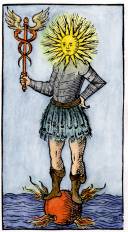
 Over 150 megabytes online of information on
alchemy in all its facets. Divided into over 2400
sections and providing tens of thousands of pages of
text, over 2500 images, over 240 complete alchemical
texts, extensive bibliographical material on the
printed books and manuscripts, numerous articles,
introductory and general reference material on
alchemy.
Over 150 megabytes online of information on
alchemy in all its facets. Divided into over 2400
sections and providing tens of thousands of pages of
text, over 2500 images, over 240 complete alchemical
texts, extensive bibliographical material on the
printed books and manuscripts, numerous articles,
introductory and general reference material on
alchemy. Join the mailing list
Join the mailing list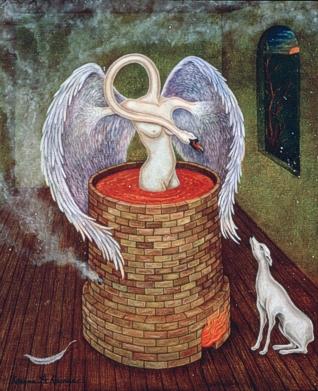
 Alchemy Web Bookshop
Alchemy Web Bookshop
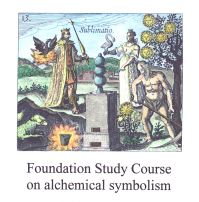
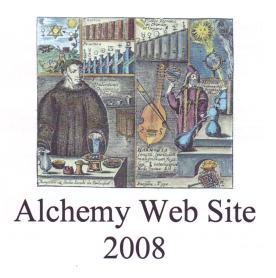
 NEW
Exploring alchemical emblems - a course
using audio visual presentations. Click for
sample.
NEW
Exploring alchemical emblems - a course
using audio visual presentations. Click for
sample.
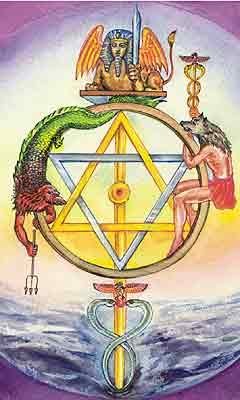
 This
website has been substantially supported by Dan Levy
since 1996 by his donation of the space and bandwith
on the
This
website has been substantially supported by Dan Levy
since 1996 by his donation of the space and bandwith
on the 















